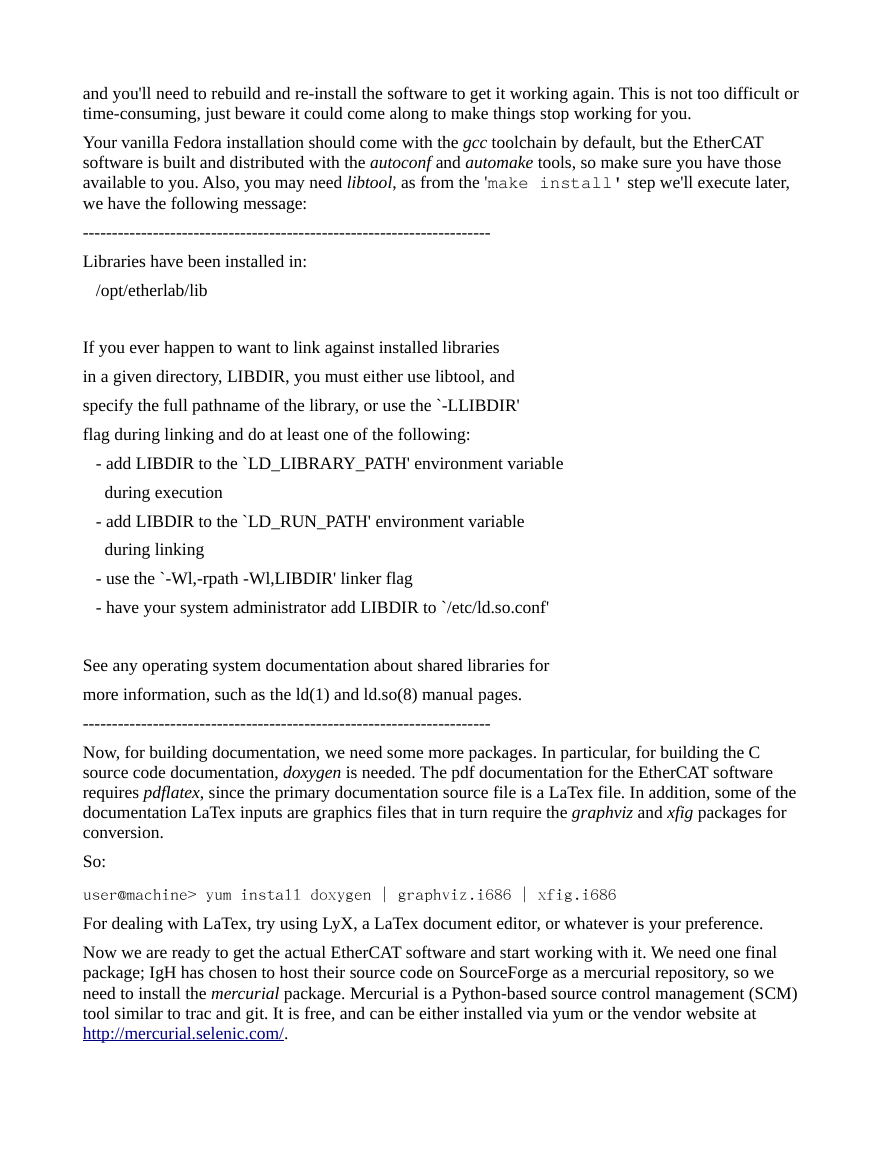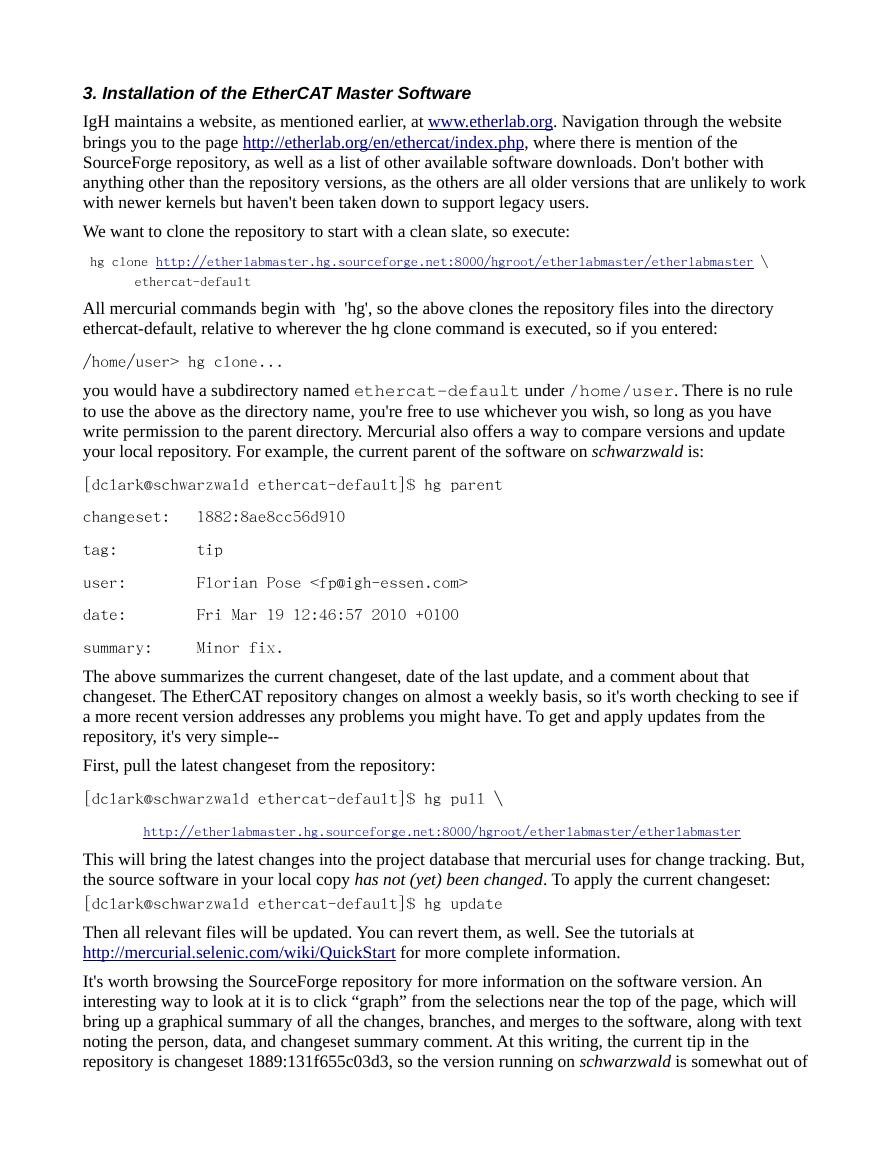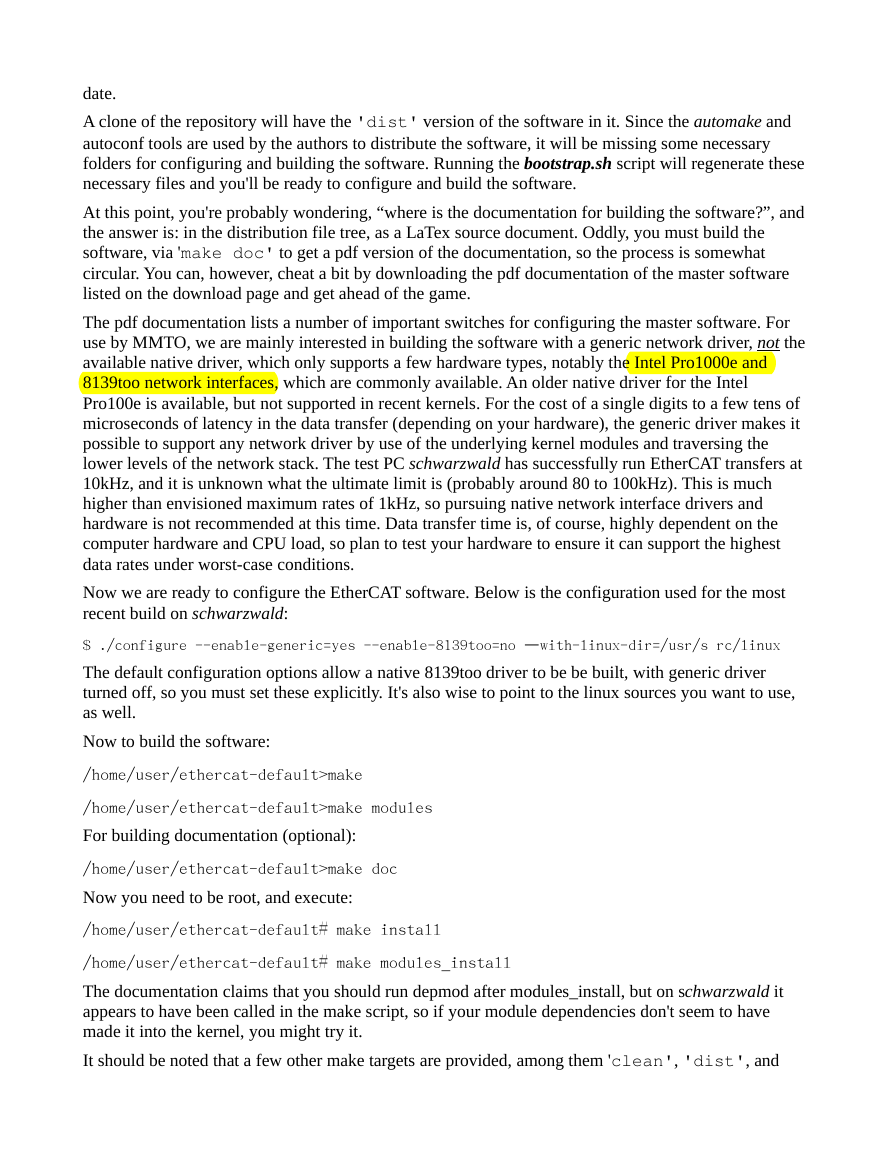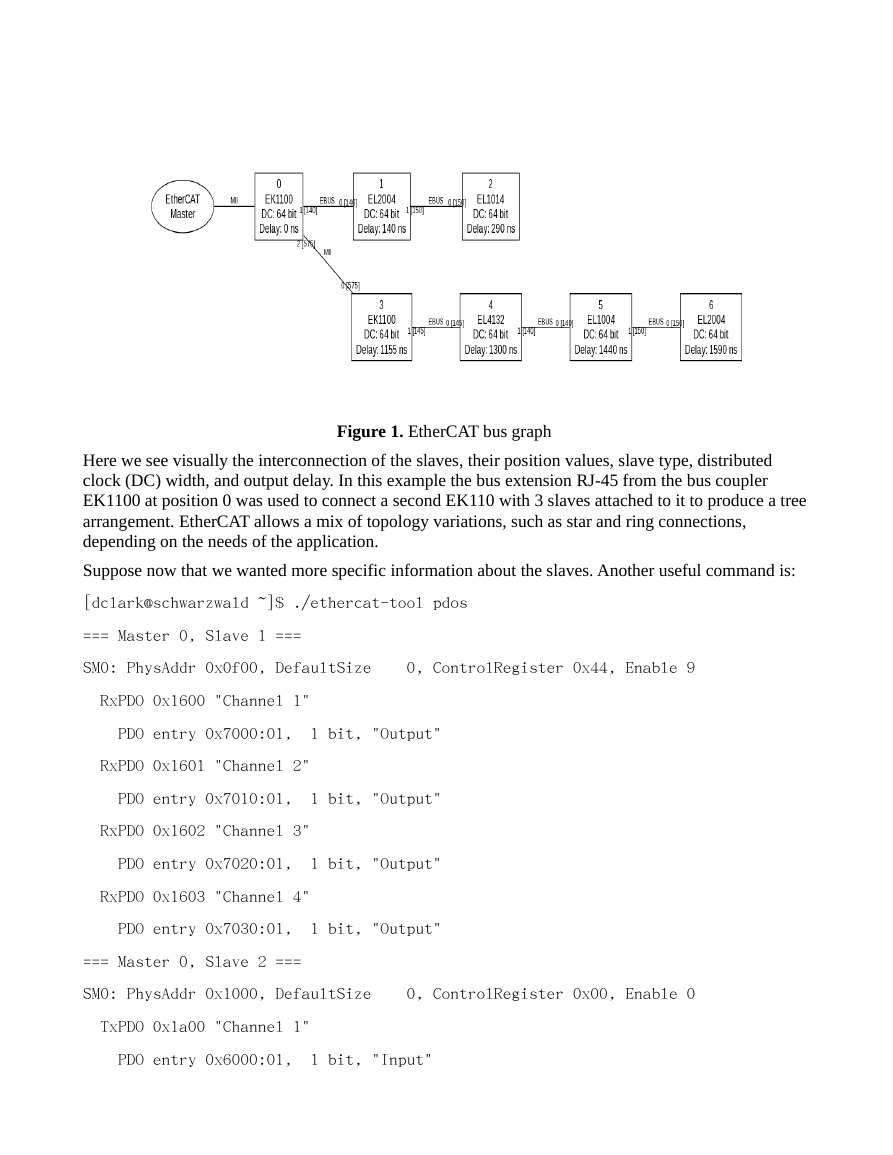MMTO EtherCAT User's Guide
D. Clark
March 31, 2010
Version 0.1
�
1. Introduction
This document describes getting, installing, and using the IgH (Ingenieurgemeinschaft) EtherCAT
master software and EtherCAT hardware from Beckhoff Automation for use in MMT systems using a
Fedora 12 Linux PC. It is not intended as an exhaustive description or detailed “how-to”, rather it is
more of a quick-start to assist knowledgeable persons in getting EtherCAT applications and hardware
working. Let's get going!
2. Prerequisites
First, you need a Linux PC running Fedora 12. You should bring the machine completely up to date,
and apply all yum updates as necessary to have a fresh installation ready to use. As of this writing, the
test machine schwarzwald is running Linux 2.6.32.9-70.fc12.i686.
2.1 Hardware Prerequisites
Next, your PC should have at least two Ethernet ports, at least one of which is an RJ-45 jack; the other
could easily be a wireless connection. The port with the RJ-45 will be dedicated to the EtherCAT
connection, and you will need a network connection on the other port for connecting to the internet for
downloading software, updates, and other uses. While EtherCAT can handle passing ordinary packet
traffic across the Ethernet interface, this is an advanced use case that is more complicated than
necessary -- network cards are inexpensive, and your motherboard may even already have two Ethernet
ports available.
Once you have a running Fedora 12 system with a working internet connection, it's time to install some
software to prepare for running EtherCAT.
2.2 Software Prerequisites
MMTO uses the IgH EtherCAT master software from www.etherlab.org. In order to effectively
download and use the software, some extra packages are required to get, build, install, and create
documentation for the software. It is recommended to go ahead and install all these packages before
starting work with EtherCAT rather than discover later something is needed and have to go back and
fix it before continuing. So, what do we need?
For building the IgH master software and documentation, we need a) the source for your running
kernel, b) gcc toolchain, c) autoconf and automake tools, d)pdflatex or equivalent for dealing with
LaTex files, e) doxygen to generate the C source code documentation, and f)xfig and graphviz for
generating documentation graphics, and g) libtool, the GNU portable library tool.
The easiest way to get the kernel source is to execute:
user@machine> yumdownloader --source kernel
Yum will then acquire and install the kernel source at the location /usr/src/kernels/$uname.
The next step is to create a symbolic link to the kernel source:
user@machine> ln -s /usr/src/kernels/$uname linux
If you have automatic updates enabled, as is usually the case with a standard Fedora installation, kernel
updates will probably update the /kernels directory with the new kernel source, but will not change the
linux symlink. You'll have to do that yourself should the need arise. If you reboot after the kernel
update, chances are you'll boot into a kernel that no longer has your EtherCAT installation available
�
and you'll need to rebuild and re-install the software to get it working again. This is not too difficult or
time-consuming, just beware it could come along to make things stop working for you.
Your vanilla Fedora installation should come with the gcc toolchain by default, but the EtherCAT
software is built and distributed with the autoconf and automake tools, so make sure you have those
available to you. Also, you may need libtool, as from the 'make install' step we'll execute later,
we have the following message:
----------------------------------------------------------------------
Libraries have been installed in:
/opt/etherlab/lib
If you ever happen to want to link against installed libraries
in a given directory, LIBDIR, you must either use libtool, and
specify the full pathname of the library, or use the `-LLIBDIR'
flag during linking and do at least one of the following:
- add LIBDIR to the `LD_LIBRARY_PATH' environment variable
during execution
- add LIBDIR to the `LD_RUN_PATH' environment variable
during linking
- use the `-Wl,-rpath -Wl,LIBDIR' linker flag
- have your system administrator add LIBDIR to `/etc/ld.so.conf'
See any operating system documentation about shared libraries for
more information, such as the ld(1) and ld.so(8) manual pages.
----------------------------------------------------------------------
Now, for building documentation, we need some more packages. In particular, for building the C
source code documentation, doxygen is needed. The pdf documentation for the EtherCAT software
requires pdflatex, since the primary documentation source file is a LaTex file. In addition, some of the
documentation LaTex inputs are graphics files that in turn require the graphviz and xfig packages for
conversion.
So:
user@machine> yum install doxygen | graphviz.i686 | xfig.i686
For dealing with LaTex, try using LyX, a LaTex document editor, or whatever is your preference.
Now we are ready to get the actual EtherCAT software and start working with it. We need one final
package; IgH has chosen to host their source code on SourceForge as a mercurial repository, so we
need to install the mercurial package. Mercurial is a Python-based source control management (SCM)
tool similar to trac and git. It is free, and can be either installed via yum or the vendor website at
http://mercurial.selenic.com/.
�
3. Installation of the EtherCAT Master Software
IgH maintains a website, as mentioned earlier, at www.etherlab.org. Navigation through the website
brings you to the page http://etherlab.org/en/ethercat/index.php, where there is mention of the
SourceForge repository, as well as a list of other available software downloads. Don't bother with
anything other than the repository versions, as the others are all older versions that are unlikely to work
with newer kernels but haven't been taken down to support legacy users.
We want to clone the repository to start with a clean slate, so execute:
hg clone http://etherlabmaster.hg.sourceforge.net:8000/hgroot/etherlabmaster/etherlabmaster \
ethercat-default
All mercurial commands begin with 'hg', so the above clones the repository files into the directory
ethercat-default, relative to wherever the hg clone command is executed, so if you entered:
/home/user> hg clone...
you would have a subdirectory named ethercatdefault under /home/user. There is no rule
to use the above as the directory name, you're free to use whichever you wish, so long as you have
write permission to the parent directory. Mercurial also offers a way to compare versions and update
your local repository. For example, the current parent of the software on schwarzwald is:
[dclark@schwarzwald ethercat-default]$ hg parent
changeset: 1882:8ae8cc56d910
tag: tip
user: Florian Pose
date: Fri Mar 19 12:46:57 2010 +0100
summary: Minor fix.
The above summarizes the current changeset, date of the last update, and a comment about that
changeset. The EtherCAT repository changes on almost a weekly basis, so it's worth checking to see if
a more recent version addresses any problems you might have. To get and apply updates from the
repository, it's very simple--
First, pull the latest changeset from the repository:
[dclark@schwarzwald ethercat-default]$ hg pull \
http://etherlabmaster.hg.sourceforge.net:8000/hgroot/etherlabmaster/etherlabmaster
This will bring the latest changes into the project database that mercurial uses for change tracking. But,
the source software in your local copy has not (yet) been changed. To apply the current changeset:
[dclark@schwarzwald ethercat-default]$ hg update
Then all relevant files will be updated. You can revert them, as well. See the tutorials at
http://mercurial.selenic.com/wiki/QuickStart for more complete information.
It's worth browsing the SourceForge repository for more information on the software version. An
interesting way to look at it is to click “graph” from the selections near the top of the page, which will
bring up a graphical summary of all the changes, branches, and merges to the software, along with text
noting the person, data, and changeset summary comment. At this writing, the current tip in the
repository is changeset 1889:131f655c03d3, so the version running on schwarzwald is somewhat out of
�
date.
A clone of the repository will have the 'dist' version of the software in it. Since the automake and
autoconf tools are used by the authors to distribute the software, it will be missing some necessary
folders for configuring and building the software. Running the bootstrap.sh script will regenerate these
necessary files and you'll be ready to configure and build the software.
At this point, you're probably wondering, “where is the documentation for building the software?”, and
the answer is: in the distribution file tree, as a LaTex source document. Oddly, you must build the
software, via 'make doc' to get a pdf version of the documentation, so the process is somewhat
circular. You can, however, cheat a bit by downloading the pdf documentation of the master software
listed on the download page and get ahead of the game.
The pdf documentation lists a number of important switches for configuring the master software. For
use by MMTO, we are mainly interested in building the software with a generic network driver, not the
available native driver, which only supports a few hardware types, notably the Intel Pro1000e and
8139too network interfaces, which are commonly available. An older native driver for the Intel
Pro100e is available, but not supported in recent kernels. For the cost of a single digits to a few tens of
microseconds of latency in the data transfer (depending on your hardware), the generic driver makes it
possible to support any network driver by use of the underlying kernel modules and traversing the
lower levels of the network stack. The test PC schwarzwald has successfully run EtherCAT transfers at
10kHz, and it is unknown what the ultimate limit is (probably around 80 to 100kHz). This is much
higher than envisioned maximum rates of 1kHz, so pursuing native network interface drivers and
hardware is not recommended at this time. Data transfer time is, of course, highly dependent on the
computer hardware and CPU load, so plan to test your hardware to ensure it can support the highest
data rates under worst-case conditions.
Now we are ready to configure the EtherCAT software. Below is the configuration used for the most
recent build on schwarzwald:
$ ./configure --enable-generic=yes --enable-8139too=no –with-linux-dir=/usr/s rc/linux
The default configuration options allow a native 8139too driver to be be built, with generic driver
turned off, so you must set these explicitly. It's also wise to point to the linux sources you want to use,
as well.
Now to build the software:
/home/user/ethercat-default>make
/home/user/ethercat-default>make modules
For building documentation (optional):
/home/user/ethercat-default>make doc
Now you need to be root, and execute:
/home/user/ethercat-default# make install
/home/user/ethercat-default# make modules_install
The documentation claims that you should run depmod after modules_install, but on schwarzwald it
appears to have been called in the make script, so if your module dependencies don't seem to have
made it into the kernel, you might try it.
It should be noted that a few other make targets are provided, among them 'clean', 'dist', and
�
'all'. See the Makefile in the /ethercat-default directory for all the targets.
4. Completing the Installation
Once the EtherCAT master software is built and installed, it's time to apply some setup information so
the master is attached to the correct Ethernet interface, and the command-line tool is available for use.
The EtherCAT master when started looks for a configuration file, /etc/sysconfig/ethercat for
variables that define which interface to use and the master device kernel module to load. For
schwarzwald, the relevant portion of the file is:
MASTER0_DEVICE="00:30:1b:ae:36:0e"
and
DEVICE_MODULES="generic"
The MASTER0_DEVICE is set to the MAC address of the desired network interface hardware, and the
module name is identified with the DEVICE_MODULES value. The file is installed with default
values during make install, and is richly commented to assist in getting the correct information.
The EtherCAT master offers a character device interface for user-space applications, so it's useful to
make a udev rule to allow read/write access for them. The rule used on schwarzwald is the file
/etc/udev/rules.d/99EtherCAT.rules, and contains only:
KERNEL=="EtherCAT[0-9]", MODE="0666"
Finally, a command-line tool is available for interacting with the master (e.g. starting, stopping, setting
debug levels, and most importantly, utilities). The tool is installed in
/opt/etherlab/bin/ethercat, so it's convenient to make a symlink to the tool binary, such as:
ethercat-tool -> /opt/etherlab/bin/ethercat
this makes it a bit easier to remember what you're doing, since a lot of different things within the
system are called, “ethercat”.
The EtherCAT master posts messages to the syslog, so you can use dmesg to get relevant information
about the master's state. For example, since we've completed the above, we can start the master (as
root):
[root@schwarzwald dclark]# /etc/init.d/ethercat start
Starting EtherCAT master devel done
Obviously in a production setup we probably want the EtherCAT to start at boot time, so set your
machine up appropriately. If the startup succeeds, we should see the “done” message above, and we
should have dmesg entries for the process, which are always prefaced with EtherCAT to make
searching the log easier:
EtherCAT: Master driver devel 8ae8cc56d910
EtherCAT: 1 master waiting for devices.
ec_generic: EtherCAT master generic Ethernet device module devel 8ae8cc56d910
EtherCAT: Accepting device 00:30:1B:AE:36:0E for master 0.
�
ec_generic: Binding socket to interface 3 (eth2).
EtherCAT: Starting EtherCAT-IDLE thread.
EtherCAT: Link state changed to UP.
EtherCAT: 3 slave(s) responding.
EtherCAT: Slave states: PREOP.
EtherCAT: Scanning bus.
EtherCAT: Bus scanning completed in 207 ms.
Notice that the EtherCAT master always reports its parent changeset value, so you can always tell
without difficulty the version that's running. It will start the master code, bring up the interface with the
MAC address in the sysconfig file, and scan the bus for any slaves that might be active before moving
to an idle state waiting for a master instance to be requested (more on this later).
5. Using the Command-line Tool
The ethercat-tool above has several useful utilities for getting information about the slaves attached to
the bus. Here, I will mention a few of the more useful ones. See the documentation for more
information about what commands are available.
One of the first things the user will want to know is that the slaves are connected, and which slaves are
connected and in what order; the command-line tool makes this possible in a couple of different ways.
The simplest is a listing of the slaves:
[dclark@schwarzwald ~]$ ./ethercat-tool slaves
0 0:0 PREOP + EK1100 EtherCAT-Koppler (2A E-Bus)
1 0:1 PREOP + EL2004 4Ch. Dig. Output 24V, 0.5A
s �
2 0:2 PREOP + EL1014 4Ch. Dig. Input 24V, 10
What is reported here is the bus segment:position for each slave (0:0 through 0:2), the slave's
application-layer state, and the slave's model and function. For more complex arrangements, you might
want to know about other bus segments and slave connections in a graphical manner. Consider the
following:
[dclark@schwarzwald ~]$ ./ethercat-tool graph | dot -Tpng > slaves7.png
which produces a graphical output of the bus connections, the slaves at each position, and the bus delay
time to each slave (next page):
�
Figure 1. EtherCAT bus graph
Here we see visually the interconnection of the slaves, their position values, slave type, distributed
clock (DC) width, and output delay. In this example the bus extension RJ-45 from the bus coupler
EK1100 at position 0 was used to connect a second EK110 with 3 slaves attached to it to produce a tree
arrangement. EtherCAT allows a mix of topology variations, such as star and ring connections,
depending on the needs of the application.
Suppose now that we wanted more specific information about the slaves. Another useful command is:
[dclark@schwarzwald ~]$ ./ethercat-tool pdos
=== Master 0, Slave 1 ===
SM0: PhysAddr 0x0f00, DefaultSize 0, ControlRegister 0x44, Enable 9
RxPDO 0x1600 "Channel 1"
PDO entry 0x7000:01, 1 bit, "Output"
RxPDO 0x1601 "Channel 2"
PDO entry 0x7010:01, 1 bit, "Output"
RxPDO 0x1602 "Channel 3"
PDO entry 0x7020:01, 1 bit, "Output"
RxPDO 0x1603 "Channel 4"
PDO entry 0x7030:01, 1 bit, "Output"
=== Master 0, Slave 2 ===
SM0: PhysAddr 0x1000, DefaultSize 0, ControlRegister 0x00, Enable 0
TxPDO 0x1a00 "Channel 1"
PDO entry 0x6000:01, 1 bit, "Input"
�
















 2023年江西萍乡中考道德与法治真题及答案.doc
2023年江西萍乡中考道德与法治真题及答案.doc 2012年重庆南川中考生物真题及答案.doc
2012年重庆南川中考生物真题及答案.doc 2013年江西师范大学地理学综合及文艺理论基础考研真题.doc
2013年江西师范大学地理学综合及文艺理论基础考研真题.doc 2020年四川甘孜小升初语文真题及答案I卷.doc
2020年四川甘孜小升初语文真题及答案I卷.doc 2020年注册岩土工程师专业基础考试真题及答案.doc
2020年注册岩土工程师专业基础考试真题及答案.doc 2023-2024学年福建省厦门市九年级上学期数学月考试题及答案.doc
2023-2024学年福建省厦门市九年级上学期数学月考试题及答案.doc 2021-2022学年辽宁省沈阳市大东区九年级上学期语文期末试题及答案.doc
2021-2022学年辽宁省沈阳市大东区九年级上学期语文期末试题及答案.doc 2022-2023学年北京东城区初三第一学期物理期末试卷及答案.doc
2022-2023学年北京东城区初三第一学期物理期末试卷及答案.doc 2018上半年江西教师资格初中地理学科知识与教学能力真题及答案.doc
2018上半年江西教师资格初中地理学科知识与教学能力真题及答案.doc 2012年河北国家公务员申论考试真题及答案-省级.doc
2012年河北国家公务员申论考试真题及答案-省级.doc 2020-2021学年江苏省扬州市江都区邵樊片九年级上学期数学第一次质量检测试题及答案.doc
2020-2021学年江苏省扬州市江都区邵樊片九年级上学期数学第一次质量检测试题及答案.doc 2022下半年黑龙江教师资格证中学综合素质真题及答案.doc
2022下半年黑龙江教师资格证中学综合素质真题及答案.doc